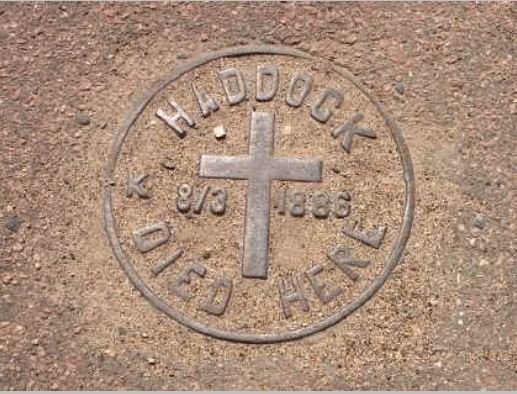Haddock, Reverend George
It was a dark and stormy night in 1886. Reverend George Haddock was returning the carriage and horses to the Jerry Merrill Livery stable at the corner of Third and Water Street when he noticed a group of men standing watching him. The time was 10:15 p.m. Reverend Haddock and a fellow minister had been visiting Greenville, a town two miles east of Sioux City. They had been looking to see if the town was violating the state liquor law.
Never a person to back away from a confrontation, Rev. Haddock started across the muddy, rain-soaked street. With a rope attached to an iron wheel in his hand and he walked toward the men. Two men started to walk toward him. One put his hands in front of his face and the other walked behind him. A single shot rang out and Rev. Haddock dropped to the muddy ground in the middle of the street. He got to his feet and stumbled to the sidewalk, falling again. He never got up. He died on the sidewalk that night.
How did a murder like this happen in a small Midwestern city? In 1886, Sioux City had 11 public schools and 18 churches. It also had 75 saloons, two breweries, and several licensed gambling houses. The city's population was swelling from 20,000 in 1880 to over 38,000 in 1890. A police department was established in 1885 to deal with the increases in lawlessness affecting this frontier town.
A magazine's depiction of Haddock's murder
In 1882 the voters in Iowa passed an amendment to the state constitution making liquor illegal in all of Iowa. Called the "Clark Law" for Senator Talton Clark who was the primary advocate of this law. The city of Sioux City ignored the law. With all the saloons and breweries, Sioux City officials fought to keep the liquor flowing. They passed a law requiring bars and breweries to pay a fine or fee of between $25 and $100 a month to stay in business. This raised a lot of money for the city.
In the summer of 1886, two murders took place in gambling houses. Both these murders involved people who had been drinking. The city was in an uproar. Haddock gave strong sermons expressing his beliefs that alcohol and gambling should be eliminated in accordance with the Iowa law.
First Methodist Church sought help in the form of Reverend Haddock. The Reverend had been fighting for prohibition all over the Midwest for over ten years. He was only five feet seven inches tall, but he weighed two hundred pounds and was often referred to as a fighting preacher. Haddock gave rousing sermons and testified against saloons in court. Other ministers who agreed with him were threatened and some left town. Rev. Haddock stayed, he knew the risks but thought his cause to be that important.
After the murder, people were interviewed and several men were identified as being responsible. The man who pulled the trigger killing Rev. Haddock was identified as John Arensdorf, the foreman of a local brewing company. He and the others were tracked down and Arensdorf went to trial accused of murder. Even though the prosecutor had eyewitnesses who saw the murder take place, Arensdorf was found not guilty at his second trial. The picture below shows Arensdorf and the members of the jury that set him free out drinking in the town the day of his acquittal. After his death and the acquittal of his murderer, Haddock accomplished what he could not while he was alive: liquor and gambling were made illegal and forced out of Sioux City. All the saloons and gambling houses moved across the river to what is now South Sioux City, Nebraska. Five years later the law was repealed outlawing liquor.
Arensdorf and the members of the jury that set him free out drinking in the town the day of his acquittal. Arensdorf is in the bottom row in the middle with his arms crossed.
The acquittal of Arensdorf drew the attention of newspapers all over the nation. The Logan Observer wrote:
"The Arensdorf trial at Sioux City is turning out to be a regular farce. The prosecutions proved clearly by several witnesses that Arensdorf killed Haddock."
The Chicago News wrote:
"Even should the spirit of Dr. Haddock himself enter the room and point to Arensdorf and say 'Thou art the man,' the jury would still not convict the accused."
The Dakotian newspaper asked,
"Does god rule, or the devil, in Sioux City?"
The Davenport Democrat stated,
"If cities were punished for their wickedness in these times, a disastrous earthquake might be predicted for the vicinity of Sioux City."
This historic marker once commemorated the location of Haddock’s murder at Fourth and Water Streets. The marker was removed in 2013 and is now at the Sioux City Public Museum.




